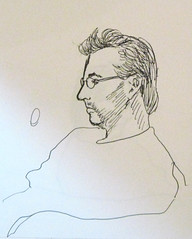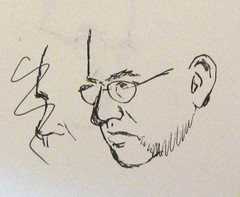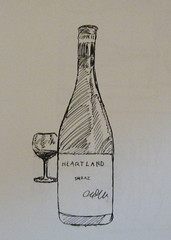Sounds great? Well, the downside is that they are (in my view) devilishly difficult to use! Here are some pictures of mine (it is a vintage specimen by Leon, from the early 20th century):




So how does it work?
In a nutshell, the traditional camera lucida works by enabling the artist to position his/her eye above a little prism that effectively splits the pupil into two, so that, although the eye is looking down at the paper below, one part of the eye is actually seeing the subject ahead superimposed onto the paper. Lenses are used when there is a need to focus, e.g. if there is a difference between the distance of the subject and the distance of the paper.

Although the camera lucida was patented by William Wollaston in 1806, there is some debate as to whether it was actually invented centuries earlier. It also experienced a resurgence of popularity in the early 20th century.
More details can be found in these articles...
- http://en.wikipedia.org/wiki/Camera_lucida
- http://painting.about.com/od/oldmastertechniques/ss/camera_lucida.htm
My Experience...
From my limited experiments, I would say that speed is of the utmost importance if you want to get the best out of your camera lucida. Once you have positioned your eye (and your subject) in the correct spot, you really must not move your head a millimetre, and your subject needs to stay absolutely still. The smallest movement can lead to a strange distorted effect when you pull your eye away and look at what you've achieved on paper.
The experimental sketches below illustrate this... each one took between 30 seconds and a minute, and of these, only one of the head studies is an accurate portrayal of the subject, with everything in the right place. The wine bottle fared better due to being a little better behaved! I suspect user error probably had a lot to do with it - I need to practice, though I doubt this will ever become a mainstream part of my drawing technique.





I have not yet tried out my camera lucida on a large plein air scene, but I fully intend to, as I believe this is one of the best ways to use it - to get the broad shapes and perspective lines in place, before switching to some old-fashioned 'eyeballing'.
Why the resurgence of interest?
In 2001, the British painter David Hockney caused a stir when he published this book, in collaboration with scientist Charles Falco...

In the book, Hockney put forward a hypothesis that many of the old masters had used various optical aids from an earlier date, and to a greater extent, than is currently believed. Among the various optical aids covered in Hockney's book is the camera lucida.
His theory triggered a fair amount of uproar from many art historians, with some of the most extreme responses found here:
Certainly, there have been some strong counter arguments made. In 2006, I attended a lecture at the National Gallery in London, entitled: "Did The Great Masters 'Cheat' using Optics? The Mysterious Rise in Naturalism in Renaissance Painting". The lecture was a direct public response to Hockney's theories by David G. Stork (Chief Scientist of Ricoh Innovations). If you missed the lecture, a paper by Stork on this topic can be seen here:
Whatever your take on the matter, I find this topic fascinating and Hockney's book is well worth reading as a feast for the eyes if nothing else. It is certainly thanks to Hockney that my interest in the camera lucida was aroused - and presumably that of countless others.
I suspect this has also led to a significant increase in their value on the antiques market... see here for a site that specialises in antique camera lucidas:
Modern Camera Lucidas
Various companies are now producing modern camera lucidas, which appear to offer a variation on the traditional prism approach, using instead a half-silvered mirror tilted at 45 degrees. I have not seen one of these in the flesh, but examples can be purchased from these vendors...
No comments:
Post a Comment
Note: only a member of this blog may post a comment.